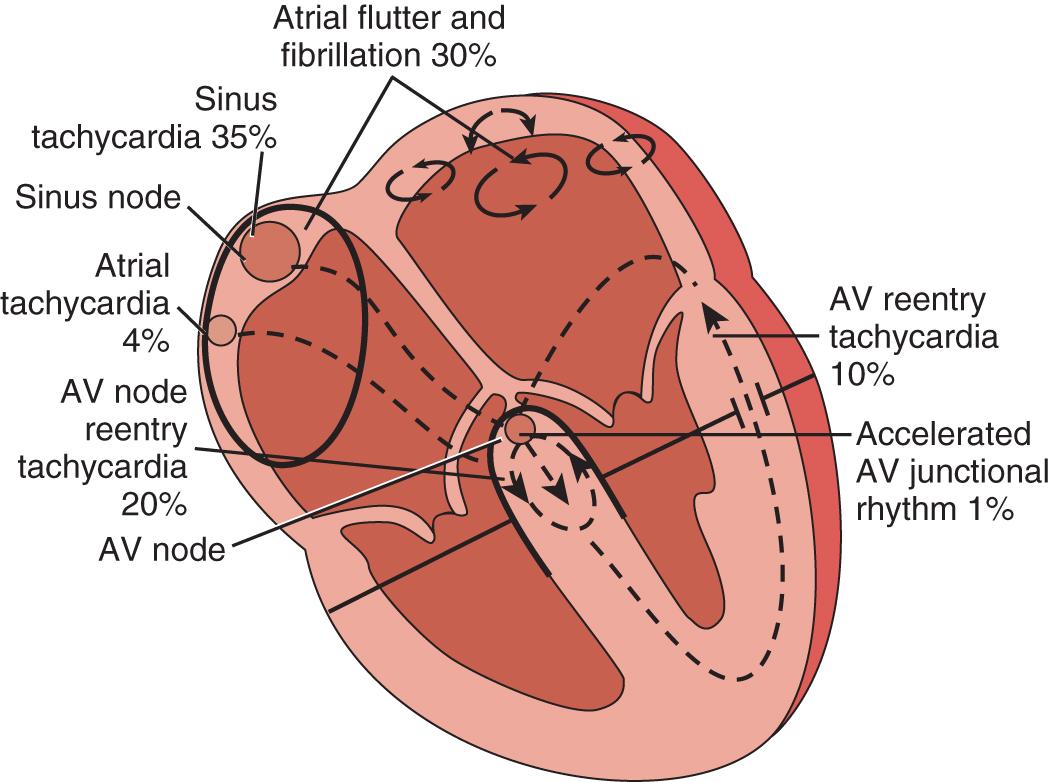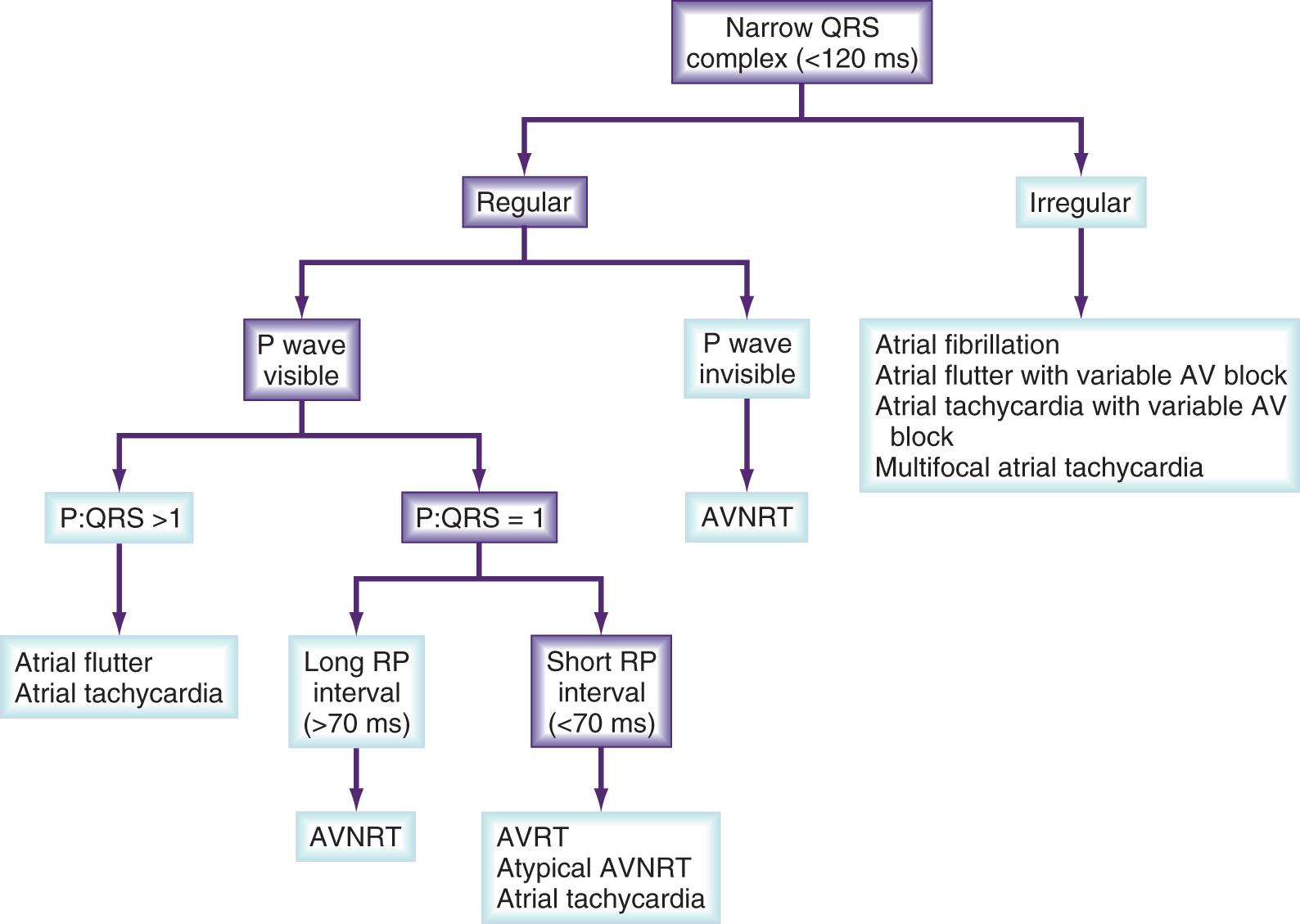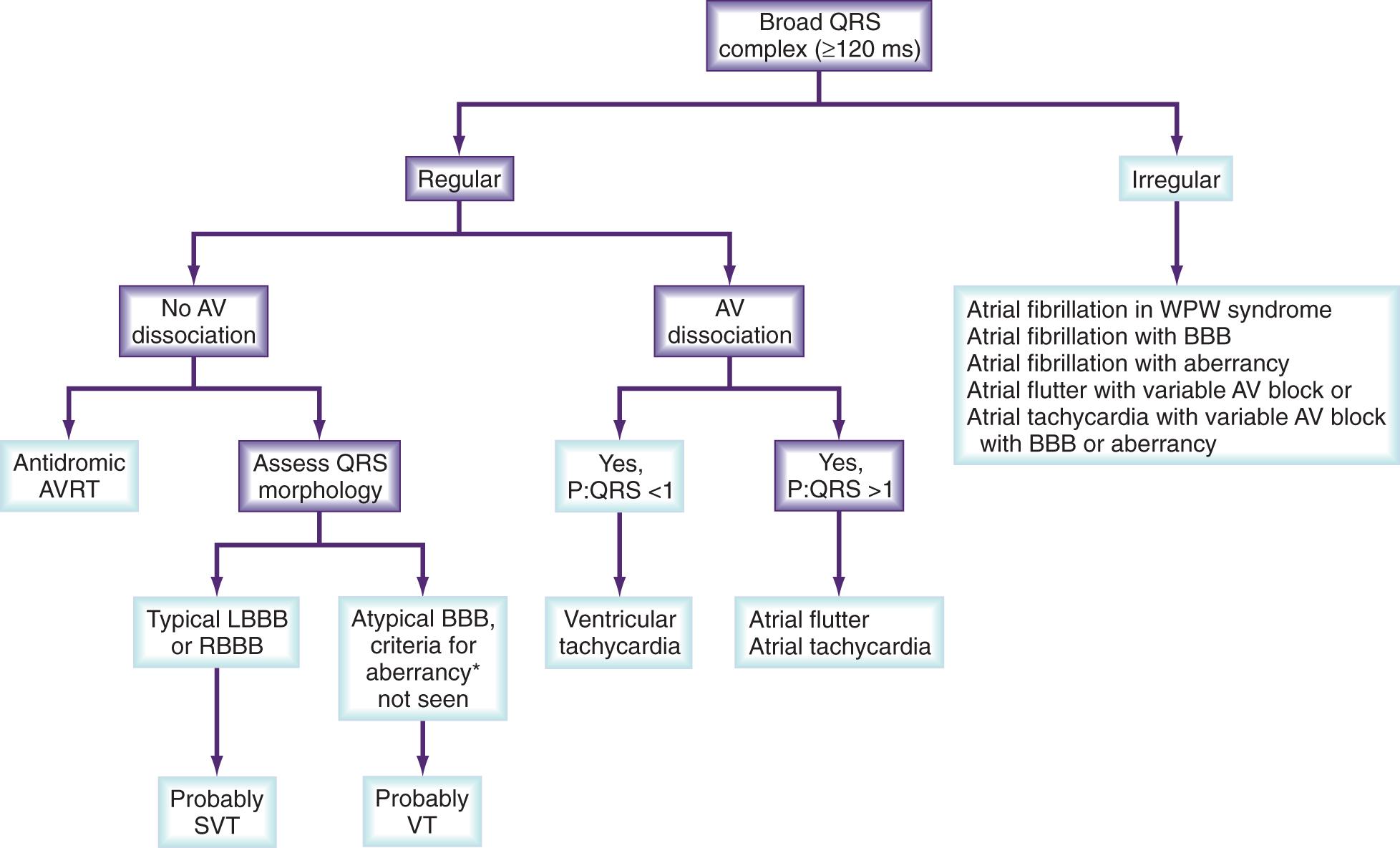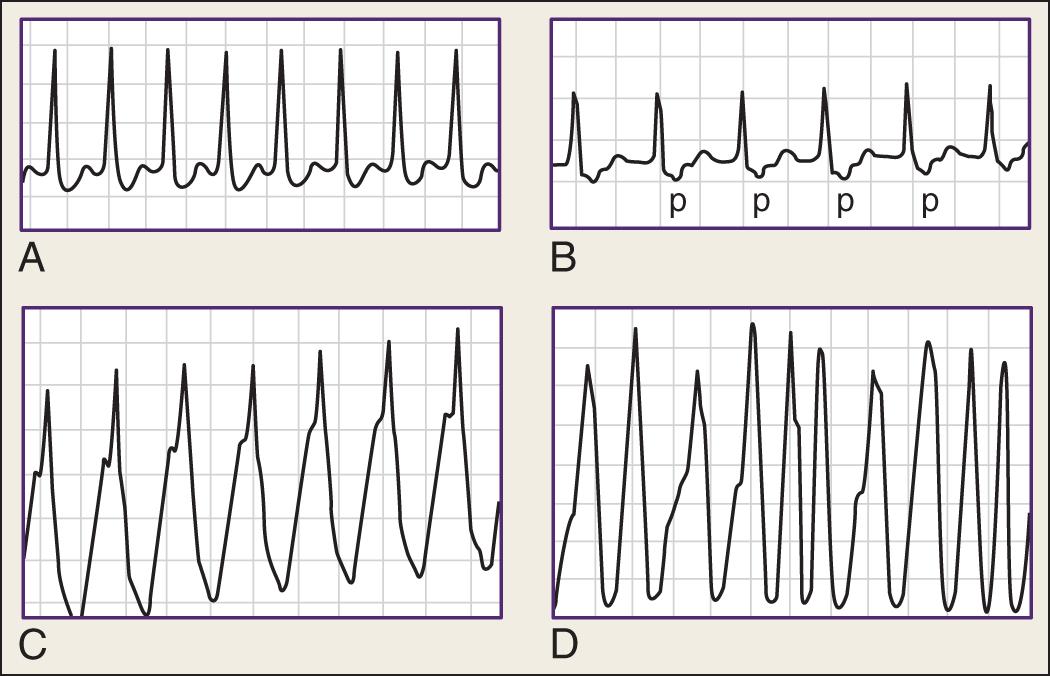Physical Address
304 North Cardinal St.
Dorchester Center, MA 02124
Supraventricular arrhythmias include rhythms arising from the sinus node and the adjacent atrial tissue (inappropriate sinus tachycardia, sinoatrial reentry tachycardia), both the right and left atria (atrial tachycardia, flutter, and fibrillation), the atrioventricular (AV) node (AV nodal reentry tachycardia, accelerated ectopic junctional rhythm), and the AV node with involvement of an accessory pathway or multiple pathways (AV reentry tachycardia) ( Fig. 71.1 ).

AV nodal reentry tachycardia and AV reentry tachycardia are usually referred to as paroxysmal supraventricular tachycardias (SVTs). They are often seen in young patients with little or no structural heart disease, although a congenital heart abnormality giving rise to increased atrial pressure and dilatation (e.g., Ebstein anomaly, atrial septal defect, Fallot tetralogy) can coexist in a small percentage of patients with these arrhythmias. The first presentation is common between age 12 and 30 years, and the prevalence is approximately 2.5 per 1000. Women are twice as likely as men to present with AV nodal reentry tachycardia.
Atrial fibrillation is the most common supraventricular arrhythmia, affecting 1%–2% of the general population, especially the elderly. It is usually associated with cardiovascular pathologies, among which hypertension and congestive heart failure prevail. About a third of patients, however, present with no underlying heart disease and are considered to have “lone” atrial fibrillation. The incidence of isolated atrial flutter is largely unknown and is believed to be in the range of 0.037%–0.88% per 1000 person-years, but at least half of these patients also have atrial fibrillation as a coexistent arrhythmia.
Atrial tachycardia affects 0.34%–0.46% of patients with arrhythmias. It is common in younger individuals after surgical correction of congenital heart disease and in the elderly, in whom it often occurs in association with atrial fibrillation.
Inappropriate sinus tachycardia and sinoatrial reentry tachycardia are less well-defined clinical and electrocardiographic entities, and their prevalence and associated conditions are not well characterized. Sinoatrial reentry tachycardia is found incidentally in 1.8%–16.9% of patients undergoing electrophysiologic studies for other supraventricular tachyarrhythmias.
The leading symptom of most supraventricular tachyarrhythmias, particularly AV nodal reentry tachycardia and AV reentry tachycardia, is rapid, regular palpitations, usually with an abrupt onset; they can occur spontaneously or be precipitated by simple movements. A common feature of tachycardias that involve circulation through the AV node is termination by the Valsalva maneuver. In younger individuals with no structural heart disease, the rapid heart rate can be the main pathologic finding. Other symptoms may include anxiety, dizziness, dyspnea, neck pulsation, central chest pain, weakness, and occasionally polyuria caused by the release of atrial natriuretic peptide in response to increased atrial pressures (more common in atrial tachycardia and AV nodal reentry tachycardia). Prominent jugular venous pulsations caused by atrial contractions against closed AV valves may be observed during AV nodal reentry or AV reentry tachycardia.
True syncope is relatively uncommon unless uncontrolled tachycardia over 200 beats per minute is sustained for a long period, especially in patients who remain standing. Syncope has been reported in 10%–15% of patients, usually just after onset of the arrhythmia or in association with a prolonged pause after its termination. However, in older patients with concomitant heart disease such as aortic stenosis, hypertrophic cardiomyopathy, and cerebrovascular disease, significant hypotension and syncope may result from profound hemodynamic collapse associated with only moderately fast ventricular rates.
It is essential to recognize that patients presenting with AV reentry tachycardia may also present with atrial fibrillation. If an accessory pathway has a short antegrade effective refractory period (<250 ms), it may conduct impulses to the ventricles at an extremely high rate and cause ventricular fibrillation. The incidence of sudden death is 0.15%–0.39% per patient-year, and this may be the first manifestation of the disease in younger individuals.
Irregular palpitations may be the result of atrial premature beats, atrial flutter with varying AV conduction block, atrial fibrillation, or multifocal atrial tachycardia. Although highly symptomatic, these arrhythmias usually have a benign hemodynamic prognosis. However, in patients with depressed ventricular function, uncontrolled atrial fibrillation can reduce cardiac output and precipitate hypotension and congestive heart failure. Atrial fibrillation in association with slow AV conduction or complete block (Frederick syndrome) may result in hemodynamic collapse. Inappropriate sinus tachycardia and nonparoxysmal accelerated junctional rhythm are characterized by relatively slow heart rates and gradual onset and termination.
Whenever possible, a 12-lead electrocardiogram (ECG) should be taken during the tachycardia. If a patient with an arrhythmia is hemodynamically unstable, a monitor strip should be obtained from the defibrillator before electrical discharge.
The typical ECG feature is narrow QRS complexes less than 120 ms. In this case, the tachycardia is almost always supraventricular, and the differential diagnosis relates to its mechanism ( Fig. 71.2 ).

The differential diagnostic features of wide-complex tachycardias favoring a supraventricular origin of the arrhythmia include but are not limited to preexistent bundle branch block; rate-dependent aberrancy; antidromic AV reentry tachycardia, when an accessory pathway conducts and excites the ventricles antegradely; and prominent electrolyte abnormalities (e.g., hypokalemia) or heart muscle disease (cardiomyopathy), all of which may result in QRS widening ( Fig. 71.3 ). If the diagnosis of SVT cannot be proved, the patient should be treated as if ventricular tachycardia is present. Immediate direct current (DC) cardioversion is the treatment for any hemodynamically unstable tachycardia.

In AV nodal reentry tachycardia, there are two functionally and anatomically different pathways within the AV node: one is characterized by a short effective refractory period and slow conduction, and the other has a longer effective refractory period and faster conduction. In sinus rhythm, the atrial impulse that depolarizes the ventricles usually conducts through the fast pathway. If the atrial impulse (e.g., an atrial premature beat) occurs early, when the fast pathway is still refractory, the slow pathway takes over in propagating the atrial impulse to the ventricles; the impulse then travels back through the fast pathway, which by then has recovered its excitability, thus initiating the most common “slow-fast,” or typical, AV nodal reentry tachycardia.
In sinus rhythm, the ECG is usually normal unless other unrelated abnormalities are present. During AV nodal reentry tachycardia, the rhythm is regular, with narrow QRS complexes and a rate of 140–250 beats per minute. The atria are activated retrogradely, producing inverted P waves in leads II, III, and aVF. Because atrial and ventricular depolarization occur simultaneously, the P waves are often obscured by the QRS complexes and cannot be detected on the surface ECG ( Fig. 71.4 A). However, in about one-third of cases of slow-fast AV nodal reentry tachycardia, a terminal positive deflection may be present in lead aVR or V 1 (or both), imitating right bundle branch block, or pseudo-S waves may be noted in the inferiorly oriented leads; these findings reflect retrograde activation of the atria. Tachycardia using these pathways in reverse (“fast-slow,” or long RP, tachycardia) is less common, occurring in 5%–10% of cases.

AV reentry tachycardia occurs as a result of an anatomically distinct AV connection termed an accessory pathway, produced by incomplete separation of the atria and ventricles during fetal development. The most common AV accessory pathway (often called a Kent bundle ) is located around the mitral or tricuspid annulus. In about 10% of cases, there are multiple pathways.
Accessory pathways are capable of conduction in either or both directions. Accessory pathways that are capable of antegrade conduction are referred to as manifest, demonstrating a delta wave during sinus rhythm when the atrial impulses conduct over the accessory pathway without encountering AV delay. The PR interval is short (<120 ms), and the QRS complex is wide; this occurs because the atrial impulse enters nonspecialized ventricular myocardium, and depolarization progresses slowly at first, giving rise to the delta wave before it is overtaken by a depolarization wavefront propagating via the normal conduction tissue. An accessory pathway that is capable of only retrograde conduction is termed concealed and does not produce a short PR interval or delta wave during sinus rhythm.
The reentry circuit of orthodromic AV reentry tachycardia involves the AV node and an accessory pathway, with the impulses conducting from the atria to the ventricles over the AV node and traveling in the reverse direction through the accessory pathway (see Fig. 71.4 B). In antidromic AV reentry tachycardia, the reentrant impulses conduct antegradely from the atria to the ventricles via an accessory pathway and retrogradely via the AV node or a second accessory pathway (see Fig. 71.4 C). Antidromic AV reentry tachycardia is uncommon (<10% of cases). Atrial fibrillation is usually encountered in patients with antegradely conducting pathways (see Fig. 71.4 D).
In an emergency, distinguishing between AV nodal reentry tachycardia and AV reentry tachycardia may be difficult, but it is usually not critical because both tachycardias respond to the same treatment. If the patient is hemodynamically stable, vagal maneuvers, including carotid sinus massage, the Valsalva maneuver, and facial immersion in cold water (diving reflex), can terminate tachycardia in about 50% of patients ( Box 71.1 ). Commercially available gel packs can be used as cold compresses instead of facial immersion, but the most important elements are wet nostrils and breath-holding.
Ensure that there is no significant carotid artery disease (carotid bruits).
Monitor the electrocardiogram continuously.
Place the patient in the supine position with the head slightly extended.
Start with right carotid sinus massage.
Apply firm rotatory or steady pressure to the carotid artery at the level of the third cervical vertebra for 5 seconds.
If no response, massage the left carotid sinus.
Generally, right carotid sinus massage decreases sinus node discharge, and left carotid sinus massage slows atrioventricular conduction.
Do not massage both carotids at the same time.
A single application of carotid sinus pressure is effective in about 20%–30% of patients with paroxysmal supraventricular tachycardias; multiple applications terminate tachycardia in about 50% of patients.
Asystole is a potential but rare complication.
Valsalva maneuver involves an abrupt voluntary increase in intrathoracic and intraabdominal pressures by straining.
Monitor the electrocardiogram continuously.
Place the patient in the supine position.
The patient should not take a deep inspiration before straining.
Ideally, the patient blows into a mouthpiece of a manometer against a pressure of 30–40 mm Hg for 15 seconds.
Alternatively, the patient strains for 15 seconds while breath-holding.
Transient acceleration of tachycardia usually occurs during the strain phase as a result of sympathetic excess.
On release of strain, the rate of tachycardia slows because of the compensatory increase in vagal tone (baroreceptor reflex); it may terminate in about 50% of patients.
Termination of tachycardia may be followed by pauses and ventricular ectopics.
Become a Clinical Tree membership for Full access and enjoy Unlimited articles
If you are a member. Log in here